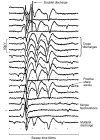Corticomotoneuronal function and hyperexcitability in acquired neuromyotonia
- PMID: 20736187
- PMCID: PMC2929332
- DOI: 10.1093/brain/awq188
Corticomotoneuronal function and hyperexcitability in acquired neuromyotonia
Abstract
Acquired neuromyotonia encompasses a group of inflammatory disorders characterized by symptoms reflecting peripheral nerve hyperexcitability, which may be clinically confused in the early stages with amyotrophic lateral sclerosis. Despite a clear peripheral nerve focus, it remains unclear whether the ectopic activity in acquired neuromyotonia receives a central contribution. To clarify whether cortical hyperexcitability contributes to development of clinical features of acquired neuromyotonia, the present study investigated whether threshold tracking transcranial magnetic stimulation could detect cortical hyperexcitability in acquired neuromyotonia, and whether this technique could differentiate acquired neuromyotonia from amyotrophic lateral sclerosis. Cortical excitability studies were undertaken in 18 patients with acquired neuromyotonia and 104 patients with amyotrophic lateral sclerosis, with results compared to 62 normal controls. Short-interval intracortical inhibition in patients with acquired neuromyotonia was significantly different when compared to patients with amyotrophic lateral sclerosis (averaged short interval intracortical inhibition acquired neuromyotonia 11.3 +/- 1.9%; amyotrophic lateral sclerosis 2.6 +/- 0.9%, P < 0.001). In addition, the motor evoked potential amplitudes (acquired neuromyotonia 21.0 +/- 3.1%; amyotrophic lateral sclerosis 38.1 +/- 2.2%, P < 0.0001), intracortical facilitation (acquired neuromyotonia -0.9 +/- 1.3%; amyotrophic lateral sclerosis -2.3 +/- 0.6%, P < 0.0001), resting motor thresholds (acquired neuromyotonia 62.2 +/- 1.6%; amyotrophic lateral sclerosis 57.2 +/- 0.9%, P < 0.05) and cortical silent period durations (acquired neuromyotonia 212.8 +/- 6.9 ms; amyotrophic lateral sclerosis 181.1 +/- 4.3 ms, P < 0.0001) were significantly different between patients with acquired neuromyotonia and amyotrophic lateral sclerosis. Threshold tracking transcranial magnetic stimulation established corticomotoneuronal integrity in acquired neuromyotonia, arguing against a contribution of central processes to the development of nerve hyperexcitability in acquired neuromyotonia.
Figures



Similar articles
-
Riluzole exerts central and peripheral modulating effects in amyotrophic lateral sclerosis.Brain. 2013 May;136(Pt 5):1361-70. doi: 10.1093/brain/awt085. Brain. 2013. PMID: 23616585
-
Cortical hyperexcitability and disease spread in amyotrophic lateral sclerosis.Eur J Neurol. 2017 Jun;24(6):816-824. doi: 10.1111/ene.13295. Epub 2017 Apr 24. Eur J Neurol. 2017. PMID: 28436181
-
Cortical hyperexcitability precedes lower motor neuron dysfunction in ALS.Clin Neurophysiol. 2015 Apr;126(4):803-9. doi: 10.1016/j.clinph.2014.04.023. Epub 2014 Aug 28. Clin Neurophysiol. 2015. PMID: 25227219
-
Reduction in short interval intracortical inhibition from the early stage reflects the pathophysiology in amyotrophic lateral sclerosis: A meta-analysis study.Eur J Neurol. 2024 Jul;31(7):e16281. doi: 10.1111/ene.16281. Epub 2024 Mar 20. Eur J Neurol. 2024. PMID: 38504632 Free PMC article.
-
Utility of transcranial magnetic stimulation in delineating amyotrophic lateral sclerosis pathophysiology.Handb Clin Neurol. 2013;116:561-75. doi: 10.1016/B978-0-444-53497-2.00045-0. Handb Clin Neurol. 2013. PMID: 24112924 Review.
Cited by
-
Transcranial Magnetic Stimulation for the Assessment of Neurodegenerative Disease.Neurotherapeutics. 2017 Jan;14(1):91-106. doi: 10.1007/s13311-016-0487-6. Neurotherapeutics. 2017. PMID: 27830492 Free PMC article. Review.
-
Association of Leucine-Rich Glioma Inactivated Protein 1, Contactin-Associated Protein 2, and Contactin 2 Antibodies With Clinical Features and Patient-Reported Pain in Acquired Neuromyotonia.JAMA Neurol. 2018 Dec 1;75(12):1519-1527. doi: 10.1001/jamaneurol.2018.2681. JAMA Neurol. 2018. PMID: 30242309 Free PMC article.
-
Neuromyotonia Confined to Faciobulbar Muscles in a Patient with Myasthenia Gravis.Mov Disord Clin Pract. 2017 Feb 1;4(4):635-636. doi: 10.1002/mdc3.12467. eCollection 2017 Jul-Aug. Mov Disord Clin Pract. 2017. PMID: 30713974 Free PMC article. No abstract available.
-
Cortical Function in Asymptomatic Carriers and Patients With C9orf72 Amyotrophic Lateral Sclerosis.JAMA Neurol. 2015 Nov;72(11):1268-74. doi: 10.1001/jamaneurol.2015.1872. JAMA Neurol. 2015. PMID: 26348842 Free PMC article.
-
Functional Biomarkers for Amyotrophic Lateral Sclerosis.Front Neurol. 2019 Jan 4;9:1141. doi: 10.3389/fneur.2018.01141. eCollection 2018. Front Neurol. 2019. PMID: 30662429 Free PMC article. Review.
References
-
- Auger RG. AAEM minimonograph #44: diseases associated with excess motor unit activity. Muscle Nerve. 1994;17:1250–63. - PubMed
-
- Brooks BR, Miller RG, Swash M, Munsat TL. El Escorial revisited: revised criteria for the diagnosis of amyotrophic lateral sclerosis. Amyotroph Lateral Scler & Other Motor Neuron Disord. 2000;1:293–9. - PubMed
-
- Cantello R, Gianelli M, Civardi C, Mutani R. Magnetic brain stimulation: the silent period after the motor evoked potential. Neurology. 1992;42:1951–9. - PubMed
-
- de Carvalho M, Bentes C, Evangelista T, Luis ML. Fibrillation and sharp-waves: do we need them to diagnose ALS? Amyotrophic Lateral Sclerosis & Other Motor Neuron Disorders. 1999;1:29–32. - PubMed
-
- de Carvalho M, Dengler R, Eisen A, England JD, Kaji R, Kimura J, et al. Electrodiagnostic criteria for diagnosis of ALS. Clin Neurophysiol. 2008;119:497–503. - PubMed

